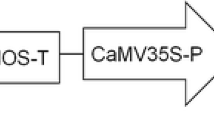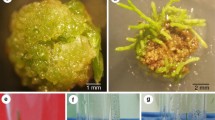Abstract
Callus selection (CS) and the flamingo-bill explant (FB) methods were evaluated for efficacy in transformation for celery. Agrobacterium tumefaciens strains EHA105 and GV3101, each with the bar gene under the promoters NOS (pGPTV-BAR) or 35S (pDHB321.1), were used. Leaf explants were inoculated and co-cultivated for 2 d in the dark. Calluses emerged on the explants on callus medium (C), Murashige and Skoog (MS) medium + 2,4-Dichlorophenoxyacetic acid (2,4-D) (2.3 μM) + kinetin (2.8 μM) + timentin (300 mg·l−1). Calluses 4- to 6-wk-old were selected for glufosinate (GS) resistance by a two step method. First, calluses were transferred to C medium + GS 0.35, 0.5, 1, 2, 5, or 10 mg·l−1; calluses formed only with 0, 0.35 and 0.5 mg·l−1 GS. All growing calluses from 0 and 0.35 mg·l−1 and a few from 0.5 mg·l−1, were divided and placed back on C + GS 0.35–0.5 mg·l−1 for another 5–6 wk. Second, tolerant clones were again divided and placed on C + GS 1–50 mg·l−1. When cultivar XP85 was inoculated with both strains, using pGPTVBAR, 19 glufosinate resistant (GR) callus clones were selected, but shoots regenerated only for strain EHA105 inoculations. When both of the strains (each with pDHB321.1) were inoculated on cv. XP166, 3 and 12 GR calluses occurred for EHA105 and GV3101, respectively. Using CS, a total of 34 GR callus clones were selected, and shoots were regenerated from over 50% of them on Gamborg B5 medium + 6-(γ, γ-dimethylallylamino) purine 2ip (4.9 μM) + naphthaleneacetic acid (NAA; 1.6 μM) and rooted on MS in 5–6 mo total time. Conversely, using FB with inoculation by GV3101/pDHB321.1 on cv. XP166 yielded putative transgenic celery plants confirmed by polymerase chain reaction (PCR) in just 6 wk. Transformation of the bar gene into celery was confirmed by PCR for 5 and 6 CS and FB lines, respectively. Southern blot analyses indicated 1–2 copies in CS lines and 1 copy in FB lines. Herbicide assays on whole plants with 100 and 300 mg·l−1 glufosinate indicated a range of low to high tolerance for lines derived by both methods. The bar gene was found to be Mendelian inherited in one self-fertile CS derived line.





Similar content being viewed by others
References
Becker D.; Kemper E.; Schell J.; Masterson R. New plant binary vectors with selectable markers located proximal to the left T-DNA border. Plant Mol. Biol. 20: 1195–1197; 1992.
Broer I. Stress inactivation of foreign genes in transgenic plants. Field Crop Res. 45: 19–25; 1996.
Brukhin V.; Clapham D.; Elfstrand M.; von Arnold S. Basta tolerance as a selectable and screening marker for transgenic plants of Norway spruce. Plant Cell Rep. 19: 899–903; 2000.
Catlin D.; Ochoa O.; McCormick S.; Quiros C. F. Celery transformation by Agrobacterium tumefaciens: cytological and genetic analysis of transgenic plants. Plant Cell Rep. 7: 100–103; 1988.
Chen C. H. Vegetative propagation of the celery plant by tissue culture. Proc. South Dakota Acad. Sci. 55: 44–48; 1976.
D’Halluin K.; Bonne E.; Bossut M.; Beuckeleer M.; Leemans J. Transgenic maize plants by tissue electroporation. Plant Cell 4: 1495–1505; 1992.
De Block M.; Botterman J.; Vandewiele M.; Dockx J.; Thoen C.; Gosselé V.; Thompson C.; Van Montagu M.; Leemans J. Engineering herbicide resistance in plants by expression of a detoxifying enzyme. EMBO J. 6: 2513–2518; 1987.
Donovan A.; Collin H.; Isaac S.; Mortimer A. M. Analysis of potential sources of variation in tissue culture derived celery plants. Ann. Appl. Biol. 124: 383–398; 1994.
Gallo-Meagher M.; Irvine J. M. Herbicide resistant transgenic sugarcane plants containing the bar gene. Crop Sci. 36: 1367–1374; 1996.
Gamborg O. L.; Miller R. A.; Ojima K. Nutrient requirements of suspension cultures of soybean root cells. Exp. Cell Res. 50: 151–158; 1968.
Hellens R.; Mullineaux P. A guide to Agrobacterium binary Ti vectors. Trends in Plant Science 5: 446–451; 2000.
Kilby N. J.; Leyser M. H. O.; Furner I. J. Promoter methylation and progressive transgene inactivation in Arabidopsis. Plant Mol. Biol. 20: 103–112; 1992.
Kumpatla S. P.; Hall T. C. Longevity of 5-azacytidine-mediated gene expression and reestablishment of silencing in transgenic rice. Plant Mol. Biol. 38: 1113–1122; 1998.
Liu C. N.; Li X. Q.; Gelvin S. B. Multiple copies of virG enhance the transient transformation of celery, carrot and rice tissue by Agrobacterium tumefaciens. Plant Mol. Biol. 20: 1071–1087; 1992.
Meyer, P., Lohuis, M. T., van Blokland, R., Heidmann, I., Niedenhof, I. (1996). The role of DNA methylation in transgene silencing in plants. In: D. Grierson, G. W. Lycett & G. A. Tucker (Eds.), Mechanisms and applications of gene silencing (pp. 43–48). Nottingham University Press.
Miki B.; McHugh S. Selectable marker genes in transgenic plants: applications, alternatives and biosafety. Plant Biotechnol. J. 107: 193–232; 2004.
Mohapatra U.; McCabe M. S.; Power J. B.; Shepers F.; van der Arend A.; Davey M. R. Expression of the bar gene confers herbicide resistance in transgenic lettuce. Transgenic Res. 8: 33–44; 1999.
Murashige T.; Skoog F. A revised medium for rapid growth and bioassays with tobacco tissue cultures. Physiol. Plant. 15: 473–497; 1962.
Noiraud N.; Maurousset L.; Lemoine R. Identification of a mannitol transporter, AgMaT1, in celery phloem. Plant Cell 13: 695–705; 2001.
Orton T. J. Genetic instability in celery tissue and cell cultures. Iowa State J. Res. 61: 481–498; 1987.
Pozueta-Romero J.; Houlne G.; Canas L.; Schantz R.; Chamarro J. Enhanced regeneration of tomato and pepper seedling explants for Agrobacterium-mediated transformation. Plant Cell Tiss. Org. Cult. 67: 173–180; 2001.
Sambrook J.; Fritsch E. F.; Maniatis T. Molecular cloning: a laboratory manual. Cold Spring Harbor Laboratory Press., Cold Spring Harbor, NY, p 111; 1989.
Saranga Y.; Rhodes D.; Janick J. Changes in amino acid composition associated with tolerance to partial desiccation of celery somatic embryos. J. Amer. Soc. Hort. Sci. 117: 337–341; 1992.
Schlink K.; Reski R. Preparing high-quality DNA from moss Physcomitrella patens. Plant Mol. Biol. Rep. 20: 423a–423f; 2002.
Thompson C. J.; Movva N. R.; Tizard R.; Gramert R.; Davies J. E.; Lauwereys M.; Botterman I. Characterization of the herbicide-resistance gene bar from Streptomyces hygroscopicus. EMBO J. 6: 2519–2523; 1987.
Toldi O.; Toth S.; Oreifig A. S.; Kiss E.; Jenes B. Production of hosphinothricintolerant rice (Oryza sativa L.) through the application of phosphinothricin as growth regulator. Plant Cell Rep. 19: 1226–1231; 2000.
Williams L.; Collin H. A. Embryogenesis and plantlet formation in tissue cultures of celery. Ann. Bot. 40: 325–332; 1976.
Acknowledgements
The authors thank Dr. B. Zandstra and Vijai Pandian, Department of Horticulture for assistance with the herbicide applications.
Author information
Authors and Affiliations
Corresponding author
Additional information
Editor: Ken C. Sink
Rights and permissions
About this article
Cite this article
Loskutov, A.V., Song, GQ. & Sink, K.C. Evaluation of methods for celery (Apium Graveolens L.) transformation using Agrobacterium tumefaciens and the bar gene as selectable marker. In Vitro Cell.Dev.Biol.-Plant 44, 239–245 (2008). https://doi.org/10.1007/s11627-008-9116-3
Received:
Accepted:
Published:
Issue Date:
DOI: https://doi.org/10.1007/s11627-008-9116-3




